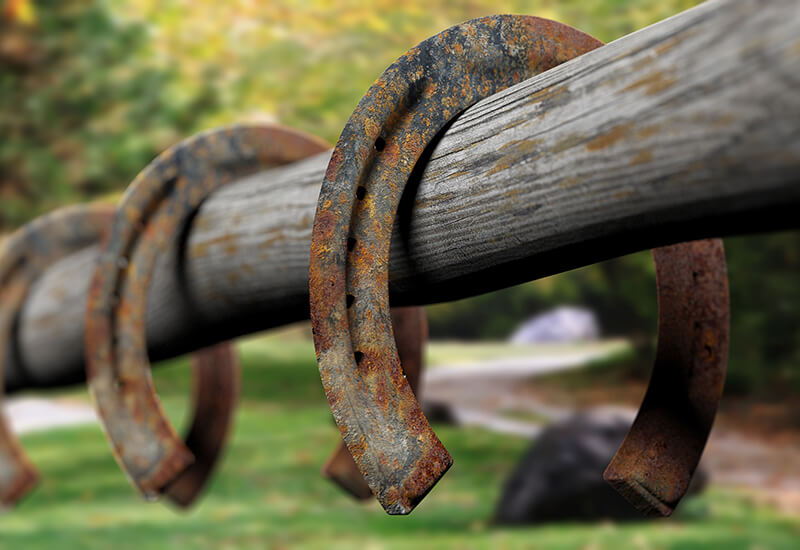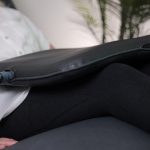The hoof of a horse provides a lot of strength and stability to our equine athletes. When the hoof is healthy, it can withstand tremendous forces and utilizes energy to assist with forward movement while providing protection for the sensitive structures beneath.
The hooves bear weight, resist wear, absorb shock, and assist with blood flow. Without healthy hooves, horses are left uncomfortable, unable to work, and sometimes in significant pain.

The hoof supports our athletes as they move and perform. The outside of the hoof is made up of the wall, sole, and frog. We are most familiar with these structures as equestrians when we pick out their hooves. The average hoof growth is one-quarter to three-eighths of an inch per month, which means the hoof wall will need regular trimming.
The sole and frog are what you see when the hoof is lifted off the ground. The sole protects the sensitive interior hoof anatomy. The frog spreads when the hoof impacts the ground and provides traction and shock absorption.
The perfect hoof should have no splits, be adequately thick to guard the delicate laminae, and have a broad frog that comes into contact with the ground when bearing the animal’s weight.
Viewing the hoof from the outside, the wall should be strong enough to withstand the elements and hold a horseshoe if applied. A hoof wall that is too soft will result in the horse frequently pulling or losing shoes. The frog will be soft and flexible, which aids it in its job of shock absorption.
Genetics, environment, and nutrition all play a key role in the horse’s ability to have solid, healthy hoofs. Some horse’s feet are predisposed to weak hooves based on genetics. Focusing on proper care and nutrition will help set your horse up for the strongest hooves possible.
Enough Caloric Intake
The first step to healthy hooves is by making sure the horses are getting enough calories from forage (hay and grazing) and grain. It is also vital that they have constant access to fresh clean water. A horse that burns more calories than he consumes will save the remaining calories for vital organs and bodily functions, while the external structures like the hooves will get the raw end of the deal.
A balanced diet is critical, as a horse that consumes an energy-rich diet that is too high in starch and sugar is at an increased risk for laminitis. This is a hoof condition where the laminae separate from the coffin bone inside the hoof. The coffin bone will start to rotate once the laminae separate which can leave the horse in a vast amount of pain. Severely overweight horses are also at an increased risk for developing metabolic conditions that can lead to laminitis.
As equestrians our goal is to make sure our horse’s are getting a well balanced diet. A balanced diet is exactly what it sounds like. Horses receive the required nutrients in the correct amounts without any imbalances or missing parts.
Protein
One essential nutrient involved in hoof health is protein. Keratin is a protein that helps the hoof maintain strength and solidity. Keratin is made up of amino acids, so be sure to feed a balanced diet that includes all ten amino acids.
Fat
This nutrient by itself doesn’t improve hoof quality, but it contributes to energy intake, which indirectly supports hoof health. Feeding fat also helps maintain a barrier in the hoof, keeping bacteria and fungi out. The barrier of the hoof is maintained when a horse’s fat intake is at the correct level. This makes it easier to block out moisture which could cause an increase in potential bacteria and fungi.
Biotin
Similar to humans taking biotin for hair, skin and nails, horses benefit from having biotin or vitamin B7 in their diet to improve hoof health. The sulfur in biotin helps strengthen the bonds between collagen found in connective tissue. The recommended dosage is 15-20 milligrams for an average 1,100-pound horse.
Grass, feed concentrates, and bran all naturally contain biotin. Check your feed bag to confirm, but your horse is most likely already receiving the recommended amount of biotin. You don’t have to worry about them getting too much since biotin is a water-soluble vitamin – your horse will excrete any excess which eliminates the risk of toxicity.
There are a lot of supplements on the market that are geared towards improving hoof health. My horses always seemed to do really well on Farrier’s Formula Double Strength. As an added bonus, this supplement always made their coat extra shiny!
Minerals
Out of all the minerals, zinc, calcium, and selenium play an important role in hoof health. Zinc helps keratinize and maintain hoof strength. Calcium helps the cells in the hoof horn attach to each other which promotes a stronger hoof. Selenium also helps build hoof strength.
Minerals are similar to amino acids as they function in groups. Changing the amount you feed your horse of just one or two minerals can disrupt absorption and how other nutrients are used in the body.
Gut Health
While gut health is not a nutrient you can give your horse, the beneficial bacteria in the digestive tract also play a vital role in hoof health. This is due to the hind gut producing B-complex vitamins, which assist with blood flow to the hoof.
While a well balanced diet will set the horse up for success, there are other factors that are also important to ensuring that their hoof health allows them to compete or live life to the fullest.
Keep it moving
Exercise and the horse’s turnout schedule are important in maintaining healthy and strong hooves. The act of walking encourages the circulation of blood within the hooves which provides them with the necessary nourishment.
The alternating pressure applied when the horse takes each step increases the metabolic processes of the hoof, resulting in the creation of stronger, healthier hooves quicker than if the animal were stationary.
This doesn’t mean that the horse should be forced into an extreme exercise routine. Turnout in a large pasture on a regular schedule will allow him to walk enough on his own to benefit his hooves.
Focus on Environment

Ground conditions in a horse’s environment can affect his hooves. Conditions that are dry will cause a hoof to shrink and harden. Wet conditions will cause a hoof to weaken and spread. Ideally a balance between wet and dry, as well as hard and soft, would be achieved in the stalls, pasture and arena.
The amount of control over your horse’s footing that you have depends on where you are located. Surface conditions can be unpredictable, but there are steps you can take to help maintain the footing for your horse.
For example, if you get chronically wet or muddy ground during each rainy season, consider spreading sand or gravel in some areas. You would especially want to do this in high traffic areas like the ground around the feeder, to give your horse some relief from standing in the muck.
In the riding arena, select a footing that creates a supportive base below the horse’s hoof. If you can see a clear imprint of the bottom of the hoof, that’s a sign of good footing because it is supporting them during each stride. In addition, riding on a variety of terrains will acclimate them to all types of footing.
All eyes on the hoof
One of the best things you can do for proper hoof care is to at least glance at them every day. You’ll be much more aware of any changes and can alert the necessary professional (either a farrier or veterinarian) to solve any issue before it gets too bad.
After you’ve picked out the hooves, take a few moments to run through these common hoof problems:
- Are there any new cracks or chips?
- If shod, are they missing a shoe or is the shoe twisted or loose?
- Is the frog firm but supple?
- Is there a strong foul odor?
Each of these questions will help you be more aware of the overall health of your horse’s hooves and be an indicator of when to alert your farrier or vet.
Pro tip!
Establish a good working relationship with your farrier and veterinarian to ensure your horse stays healthy and sound.
If you have any questions on PEMF and how it can support the overall wellness of your horse, please give Pulse PEMF a call at 770-334-2226 or email us at info@pulsepemf.com.












